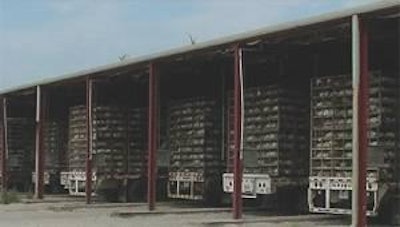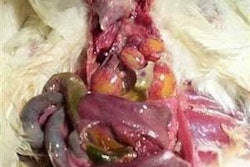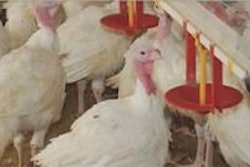
Truck shrink and poultry that are dead on arrival (DOA) at the processing plant are, unfortunately, always with us to some degree, but are at their worst in the summer months. Definitive causes of DOAs can be difficult to attribute, live production, live haul and the plant can each play a role in minimizing the number of DOAs.
The live haul process can be divided into three segments: 1) pre-transport, which includes flock health status, catch, and caging; 2) transport; and 3) post-transport, which includes holding and live hang. Understanding the issues associated with each of these live haul segments will assist in taking measures to reduce summertime DOAs.
Pre-transport
Studies at the University of Georgia have indicated that up to 40% of total DOA can be attributed to flock health status. Maintaining high immune and health status of the flock on the farm throughout the flock life cycle will reduce DOAs caused by disease conditions, allowing birds to cope better with live haul-induced stress placed upon them.
Birds that become DOA as a result of physical trauma, heat stress and asphyxia during catch and transport to the processing plant constitute the majority of birds that become DOA. Research at the University of Georgia indicates that the live haul process (from catch and transport) can contribute more than 50% of the DOA recorded for a given flock. Physical trauma such as leg and rib fractures, dislocations, and localized injuries with hemorrhaging incurred during catching and loading may lead directly to death or reduce a bird’s ability to tolerate additional live haul stresses and environmental conditions experienced during transport.
It is during catch when most birds are injured, particularly with inexperienced or insufficiently trained workers. Carrying 4-5 birds in each hand puts a lot of pressure on some birds, causing legs to become disjointed. The swinging motion used by shorter workers to lift the birds into the top cages cause perhaps the most damage to the legs as the combined weight of the birds pushes down on the leg joints of each bird, contributing to fractures and dislocation.
Training of catchers needs to be emphasized. Financial incentives for catching crews to encourage careful handling can reduce DOAs.
Pre-transport heat stress
In-house crowding during catching and catch delays can result in conditions of elevated temperature for extended periods of time. These high temperatures contribute to heat stress in the house, setting the stage for death loss later in the live haul process. Most of the mortality that occurs during catch occurs in the back half of the house as prolonged crowding and elevated house temperatures persist during the load out process. While some crowding is necessary to facilitate efficient catching, excessive crowding for extended periods of time should be avoided.
Human activity within the house prior to catch can prematurely crowd birds. Last minute raising of equipment and premature placement of separator curtains can induce excessive crowding, particularly in the back half of the house.
Once loaded into coops, birds should be positioned on their feet to avoid asphyxia. While this isn’t possible during the actual loading process, checking the coops to make sure the birds are on their feet prior to stacking on the trailer can be accomplished. Some company catch supervisors inspect the coops prior to placement on the trailer, flipping those birds that haven’t righted themselves onto their breast, using a short pole that reaches into the coop.
During hot weather, broilers can become heat stressed easily; particularly those birds caught during daylight hours or that have been raised in tunnel ventilated housing and not accustomed to large increases in temperature. When possible, catching and loading should be timed for the coolest part of the day. Live haul operations that extend into the hottest part of the day must take additional precautions to minimize conditions that will induce or exacerbate heat stress.
Establishing optimal air movement through the coops as soon as possible after loading can help to minimize heat stress related DOAs. Standard industry practices to reduce DOA during hot weather include wetting caged birds with a water hose to take advantage of evaporative cooling. Portable fan trailers are an example of new equipment and management practices that have emerged to assist in reducing DOA percentages.
These trailers can have a dramatic cooling effect on birds as they wait for transport. The fan trailers are situated next to trailers with birds in coops being loaded and blow a water mist through the caged birds. Fan trailers appear to alleviate elevated deep body temperature more than current practices that may only provide superficial cooling. Fan trailers have shown a 30-50% reduction of DOAs over conventional methods in field trials. This form of cooling and temperature control of caged birds prior to transport is rapidly spreading throughout the industry.
Transport
Loaded trailers should not be held on the farm for any length of time during hot weather. DOAs have been observed to exceed 10% of the trailer load with insufficient ventilation and cooling prior to a delayed departure.
Normal transport does not appear to be a contributing factor in elevated thermal stress here in the U.S. as our poultry production houses are typically within 50 miles of processing facilities. European studies that have looked at transport time as it correlates to poultry DOA have concluded that transport that exceeds 2 hours in duration can significantly increase the incidence of DOA attributable to thermal stress.
Post –transport
Ideally the live haul process will be scheduled so that broilers are processed as soon as they arrive at the plant. This will minimize shrink, reduce contamination and condemnation, and maximize the use of transport equipment. However, the delay before processing can frequently be several hours, as many processing plants create a cushion of trailers waiting to be processed to prevent any processing line interruptions. If efforts are not made to keep the birds cool during this period, additional DOA and shrink losses can occur.
Trailers should be processed on a “first come, first processed” basis. This reduces the length of time each trailer may be under heat stress conditions from the overall live haul experience.
Once birds have arrived at the processing plant, the holding sheds can be an additional location where thermal stress can be managed. However, this location can be another area where heat stress can occur particularly where there is insufficient ventilation in the bays or when trailers receive direct sunlight due to insufficient shade or area under roof. Complete shade and high volume fans coupled with evaporative cooling are necessary to keep birds cool prior to processing. The number of fans within the holding shed should be sufficient to hit all birds throughout the trailer with some direct ventilation, not just a few coops in the bottom middle of the trailer. Top level coops need just as must ventilation as do the lower level coops and perhaps more as they are closer to the uninsulated tin roofs typically seen on holding sheds.
Birds can rapidly receive additional temperature stress if they are parked in full sun for even short periods of time. Therefore, during summertime, if trailers arrive and there is no space within the holding shed, it is recommended that the truck be kept in motion until adequate space is made available.
Birds can also die from trauma or asphyxia during off-loading at the plant. These DOA are caused by damaged cages, malfunctioning equipment and dump operator error. Equipment maintenance is an area that needs continuous attention in order to reduce injuries and DOA associated with damaged coops and offloading equipment. In the off-loading/live hang area of the plant, providing additional ventilation directly onto the offloading belt is recommended. Ensure that the unloading operator at the plant is well trained to pay attention to conditions that may increase mortality on the belt. Raising tipped coops as soon as they are dumped will reduce the incidence of last minute asphyxia.
Bottom line
The thermal environment during catch, caging and during holding at the processing plant are primary points where heat stress impacts broilers. The transport phase of live haul does not appear to be a time of heat stress, whereas the pre-transport and post-transport segments hold the potential for significant risk of heat stress. Establishing and implementing appropriate practices that will ensure the humane catching, transport, and slaughter of poultry is an area that will continue to be a challenge in the future and can have significant impact on profit margins.

















